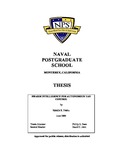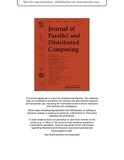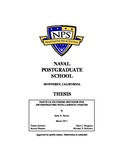Swarm intelligence for autonomous UAV control
| dc.contributor.advisor | Pace, Phillip E. | |
| dc.contributor.author | Frantz, Natalie R. | |
| dc.date.accessioned | 2012-03-14T17:34:19Z | |
| dc.date.available | 2012-03-14T17:34:19Z | |
| dc.date.issued | 2005-06 | |
| dc.identifier.uri | https://hdl.handle.net/10945/2152 | |
| dc.description.abstract | Unmanned Aerial Vehicles (UAVs) are becoming vital warfare platforms because they significantly reduce the risk of human life while accomplishing important missions. A UAV can be used for example, as stand-in sensor for the detection of mobile, low-probability-of-intercept battlefield surveillance and fire control emitters. With many UAVs acting together as a swarm, the location and frequency characteristics of each emitter can be accurately determined to continuously provide complete battlefield awareness. The swarm should be able to act autonomously while searching for targets and relaying the information to all swarm members. In this thesis, two methods of autonomous control of a UAV swarm were investigated. The first method investigated was the Particle Swarm Optimization (PSO) algorithm. This technique uses a non-linear approach to minimize the error between the location of each particle and the target by accelerating particles through the search space until the target is found. When applied to a swarm of UAVs, the PSO algorithm did not produce the desired performance results. The second method used a linear algorithm to determine the correct heading and maneuver the swarm toward the target at a constant velocity. This thesis shows that the second approach is more practical to a UAV swarm. New results are shown to demonstrate the application of the algorithm to the swarm movement. | en_US |
| dc.description.uri | http://archive.org/details/swarmintelligenc109452152 | |
| dc.format.extent | xviii, 112 p. : ill. (some col.) ; | en_US |
| dc.publisher | Monterey California. Naval Postgraduate School | en_US |
| dc.rights | This publication is a work of the U.S. Government as defined in Title 17, United States Code, Section 101. Copyright protection is not available for this work in the United States. | en_US |
| dc.subject.lcsh | Swarming (Military science) | en_US |
| dc.subject.lcsh | United States | en_US |
| dc.subject.lcsh | Drone aircraft | en_US |
| dc.title | Swarm intelligence for autonomous UAV control | en_US |
| dc.type | Thesis | en_US |
| dc.contributor.secondreader | Jenn, David C. | |
| dc.contributor.corporate | Naval Postgraduate School (U.S.). | |
| dc.contributor.department | Department of Electrical and Computer Engineering | |
| dc.identifier.oclc | 61762268 | |
| etd.thesisdegree.name | M.S. | en_US |
| etd.thesisdegree.level | Masters | en_US |
| etd.thesisdegree.discipline | Electrical Engineering | en_US |
| etd.thesisdegree.grantor | Naval Postgraduate School | en_US |
| etd.verified | no | en_US |
Files in this item
This item appears in the following Collection(s)
-
1. Thesis and Dissertation Collection, all items
Publicly releasable NPS Theses, Dissertations, MBA Professional Reports, Joint Applied Projects, Systems Engineering Project Reports and other NPS degree-earning written works.





